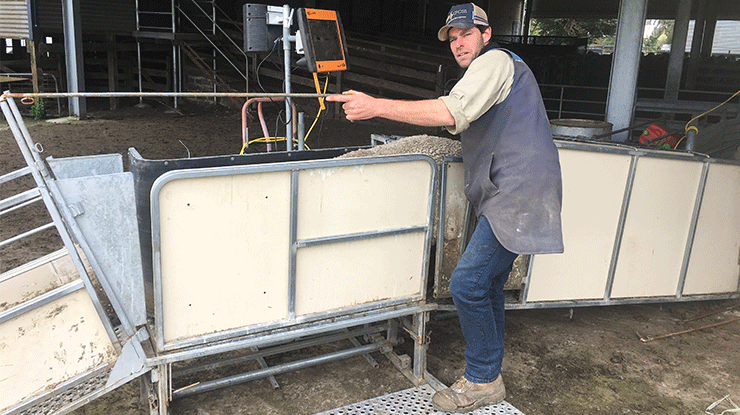Weighing up eID delivers efficiency gains
25 March 2021
 Edward Blackwell uses eID and weighing technology to make informed decisions.
Edward Blackwell uses eID and weighing technology to make informed decisions.
Efficiency is the name of the game for brothers Edward and Charles Blackwell, who run a sheep and cattle enterprise at Dunkeld in south‑west Victoria.
With just the two of them responsible for day‑to‑day operations, they only adopt new practices that will either help them be more efficient or make better decisions.
They’ve applied this mentality to using electronic identification (eID) to help make better decisions, taking a cautious approach about the type of data they collect.
“I’m not going to collect data for the sake of collecting data,” Edward said.
The Blackwells started using eID when classing heifers within their beef enterprise and have now extended the process to their sheep, when classing ewe hoggets. They also use eID to monitor the performance of different classes of sheep throughout the year.
The process begins early, at lamb marking, as their whole eID decision‑making system revolves around getting tags in the lambs and recording key information.
The attention to detail at this point makes the whole system work and allows the Blackwells to get the most out of their time invested in eID use.
“At lamb marking we record whether they were born single or twin, whether from a maiden or older ewe, which sire team they were sired by and an average date of birth,” Edward said.
Most of this information is achieved just by keeping a track of the tag sequence that is used in each mob, then matching this up later on with the tag bucket file in the software they are using.
“I’ve got my head around the software and find it easy enough to use, so we just record the sex at lamb marking time and keep track of which tags go in which mob to gather the rest of the information we need,” Edward said.
“We do a bit of trialling with different ram teams and have found the eID perfect for this.”
The ewes that are mated to a particular ram team are all recorded so they can be drafted back into that mob for lambing. This way, all lambs born can be recorded against the sire team.
Later, during the classing process, the brothers pull up all the information available on each hogget on the screen – they know whether it’s born a twin or single, the age of its dam and the sire group. They also have the animal’s most recent weight and the average daily gain in front of them.
Data‑backed decisions
The Blackwells use eID to improve the accuracy of their decisions as well as to monitor and confirm that they’re on the right track.
“It definitely doesn’t make the job quicker but it does improve the accuracy,” Edward said.
“I enjoy weighing sheep and seeing the weight gains because it helps confirm we are on the right track – and if we are not on the right track, then early intervention is certainly better than later.”
While their system is functional, they haven’t over‑invested.
“It’s not a whiz‑bang set‑up but it works,” Edward said.
It takes around an hour to weigh 600 sheep through their system.
What gets weighed:
The Blackwells’ weighing strategy includes:
- Young sheep: Each animal is weighed around six times (timing depends on the season) in its first year, to make sure it’s meeting its targets.
- Containment and feedlot: During full containment feeding in summer, the Blackwells increase the frequency of weighing to identify any poor doers and respond accordingly. The lambs being finished in the feedlot are regularly weighed to identify shy feeders.
- Ewes: The Blackwells record pregnancy status for each ewe as well as whether she raised a lamb by wet and drying at weaning. This information is combined with the ewe’s previous results – if it’s lost more than one lamb in three years it’s culled.
They also do some targeted weighing of adult ewes soon after the lambs are weaned, with two weigh‑ins a fortnight apart to monitor their recovery. They used to do this by condition scoring but have found it’s easier to get labour to push sheep through the weigh crate than to get labour with the skills to condition score accurately and consistently.
|
Lessons learned
|


